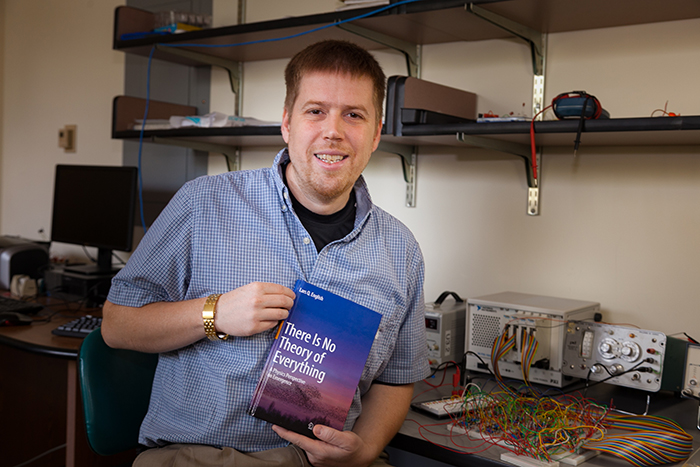'There Is No Theory of Everything'

Associate Professor of Physics Lars English. Photo by Carl Socolow '77.
Physics professor champions the unexpected and new
by MaryAlice Bitts-Jackson
When string theory came on the scene, it promised to revolutionize the way we think about the physical sciences. It puts forth that all four independent fundamental forces (gravity, electromagnetic force, the weak and strong nuclear forces) are tied together as part of the same framework, and that one set of equations, or even one equation, will soon be developed to predict and explain—well, pretty much everything.
It’s a tantalizing idea, and one championed in much current general-level science literature, including Brian Greene’s 2010 blockbuster The Elegant Universe. But it cannot hold, writes Associate Professor of Physics Lars English, in his new book.
In There Is No Theory of Everything: A Physics Perspective on Emergence, English asserts that there is no one set of rules that can unite the general theory of relativity (addressing the large-scale, universe-sized questions) with quantum mechanics (the study of microscopic or subatomic structures), because what is true at the quantum level is not necessarily true at the gravitational level. And the bigger and more complex the system, the more different the whole is from the elements that make it up.
“It’s not that these rules [for gravity] contradict quantum mechanics, but they also aren’t derivable from quantum physics,” he says. “They’re related, but separate.”
In language aimed toward a general readership, English points to phenomena in the physical, biological and social sciences alike to underscore this point. He notes, for example, that the way a murmuration of starlings will respond to a hawk cannot be predicted by the way that a single starling responds to that same hawk, and vice versa, because, like humans, the starlings will act differently—relationally—when they’re part of a group. Human thoughts cannot be predicted by neurons alone. Particles fused at the quantum level mirror each other, even when at a great distance from each other, and so cannot be described separate from each other. The whole, then, is more “real” than its parts. Graphite and diamond are both made up entirely of carbon, so you cannot predict the properties of, say, graphite based on those of a single carbon atom.
It adds up to a complicated, and thrillingly variable, existence.
“It’s about relation and organization, not just composition,” says English, who applies the idea of emergence to religious belief in the book’s final chapter. “And as you ramp up complexity, new and unexpected things happen.”
TAKE THE NEXT STEPS
Published September 11, 2017